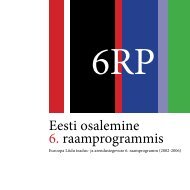Reactive Systems: Modelling, Specification and Verification - Cs.ioc.ee
Reactive Systems: Modelling, Specification and Verification - Cs.ioc.ee
Reactive Systems: Modelling, Specification and Verification - Cs.ioc.ee
Create successful ePaper yourself
Turn your PDF publications into a flip-book with our unique Google optimized e-Paper software.
3.3. STRONG BISIMILARITY 45<br />
Obviously, (s, t) ∈ R. We have to show that R is a strong bisimulation, i.e., that<br />
it m<strong>ee</strong>ts the requirements stated in Definition 3.2. To this end, for each pair of<br />
states from R, we have to investigate all the possible transitions from both states<br />
<strong>and</strong> s<strong>ee</strong> whether they can be matched by corresponding transitions from the other<br />
state. Note that a transition under some label can be matched only by a transition<br />
under the same label. We will now present a complete analysis of all of the steps<br />
n<strong>ee</strong>ded to show that R is a strong bisimulation, even though they are very simple<br />
<strong>and</strong> tedious.<br />
• Let us consider first the pair (s, t):<br />
– transitions from s:<br />
∗ s a → s1 can be matched by t a → t1 <strong>and</strong> (s1, t1) ∈ R,<br />
∗ s a → s2 can be matched by t a → t1 <strong>and</strong> (s2, t1) ∈ R, <strong>and</strong><br />
∗ these are all the transitions from s;<br />
– transitions from t:<br />
∗ t a → t1 can be matched, e.g, by s a → s2 <strong>and</strong> (s2, t1) ∈ R (another<br />
possibility would be to match it by s a → s1 but finding one<br />
matching transition is enough), <strong>and</strong><br />
∗ this is the only transition from t.<br />
• Next we consider the pair (s1, t1):<br />
– transitions from s1:<br />
∗ s1 b → s2 can be matched by t1 b → t1 <strong>and</strong> (s2, t1) ∈ R, <strong>and</strong><br />
∗ this is the only transition from s1;<br />
– transitions from t1:<br />
∗ t1 b → t1 can be matched by s1 b → s2 <strong>and</strong> (s2, t1) ∈ R, <strong>and</strong><br />
∗ this is the only transition from t1.<br />
• Finally we consider the pair (s2, t1):<br />
– transitions from s2:<br />
∗ s2 b → s2 can be matched by t1 b → t1 <strong>and</strong> (s2, t1) ∈ R, <strong>and</strong><br />
∗ this is the only transition from s2;<br />
– transitions from t1:<br />
∗ t1 b → t1 can be matched by s2 b → s2 <strong>and</strong> (s2, t1) ∈ R, <strong>and</strong><br />
∗ this is the only transition from t1.
















